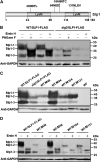N-glycosylation of effector proteins by an α-1,3-mannosyltransferase is required for the rice blast fungus to evade host innate immunity
- PMID: 24642938
- PMCID: PMC4001389
- DOI: 10.1105/tpc.114.123588
N-glycosylation of effector proteins by an α-1,3-mannosyltransferase is required for the rice blast fungus to evade host innate immunity
Abstract
Plant pathogenic fungi deploy secreted effectors to suppress plant immunity responses. These effectors operate either in the apoplast or within host cells, so they are putatively glycosylated, but the posttranslational regulation of their activities has not been explored. In this study, the ASPARAGINE-LINKED GLYCOSYLATION3 (ALG3)-mediated N-glycosylation of the effector, Secreted LysM Protein1 (Slp1), was found to be essential for its activity in the rice blast fungus Magnaporthe oryzae. ALG3 encodes an α-1,3-mannosyltransferase for protein N-glycosylation. Deletion of ALG3 resulted in the arrest of secondary infection hyphae and a significant reduction in virulence. We observed that Δalg3 mutants induced massive production of reactive oxygen species in host cells, in a similar manner to Δslp1 mutants, which is a key factor responsible for arresting infection hyphae of the mutants. Slp1 sequesters chitin oligosaccharides to avoid their recognition by the rice (Oryza sativa) chitin elicitor binding protein CEBiP and the induction of innate immune responses, including reactive oxygen species production. We demonstrate that Slp1 has three N-glycosylation sites and that simultaneous Alg3-mediated N-glycosylation of each site is required to maintain protein stability and the chitin binding activity of Slp1, which are essential for its effector function. These results indicate that Alg3-mediated N-glycosylation of Slp1 is required to evade host innate immunity.
Figures








Similar articles
-
Effector-mediated suppression of chitin-triggered immunity by magnaporthe oryzae is necessary for rice blast disease.Plant Cell. 2012 Jan;24(1):322-35. doi: 10.1105/tpc.111.092957. Epub 2012 Jan 20. Plant Cell. 2012. PMID: 22267486 Free PMC article.
-
Functional Analysis of Mannosyltransferase-Related Genes UvALGs in Ustilaginoidea virens.Int J Mol Sci. 2025 Mar 25;26(7):2979. doi: 10.3390/ijms26072979. Int J Mol Sci. 2025. PMID: 40243604 Free PMC article.
-
Comparative Secretome Analysis of Magnaporthe oryzae Identified Proteins Involved in Virulence and Cell Wall Integrity.Genomics Proteomics Bioinformatics. 2022 Aug;20(4):728-746. doi: 10.1016/j.gpb.2021.02.007. Epub 2021 Jul 18. Genomics Proteomics Bioinformatics. 2022. PMID: 34284133 Free PMC article.
-
Toward understanding of rice innate immunity against Magnaporthe oryzae.Crit Rev Biotechnol. 2016;36(1):165-74. doi: 10.3109/07388551.2014.946883. Epub 2014 Sep 8. Crit Rev Biotechnol. 2016. PMID: 25198435 Review.
-
Investigating the cell biology of plant infection by the rice blast fungus Magnaporthe oryzae.Curr Opin Microbiol. 2016 Dec;34:147-153. doi: 10.1016/j.mib.2016.10.001. Epub 2016 Nov 3. Curr Opin Microbiol. 2016. PMID: 27816794 Review.
Cited by
-
The MoPah1 phosphatidate phosphatase is involved in lipid metabolism, development, and pathogenesis in Magnaporthe oryzae.Mol Plant Pathol. 2022 May;23(5):720-732. doi: 10.1111/mpp.13193. Epub 2022 Feb 21. Mol Plant Pathol. 2022. PMID: 35191164 Free PMC article.
-
The essential effector SCRE1 in Ustilaginoidea virens suppresses rice immunity via a small peptide region.Mol Plant Pathol. 2020 Apr;21(4):445-459. doi: 10.1111/mpp.12894. Epub 2020 Feb 22. Mol Plant Pathol. 2020. PMID: 32087618 Free PMC article.
-
A candidate RxLR effector from Plasmopara viticola can elicit immune responses in Nicotiana benthamiana.BMC Plant Biol. 2017 Apr 14;17(1):75. doi: 10.1186/s12870-017-1016-4. BMC Plant Biol. 2017. PMID: 28410577 Free PMC article.
-
Live cell imaging of plant infection provides new insight into the biology of pathogenesis by the rice blast fungus Magnaporthe oryzae.J Microsc. 2025 Mar;297(3):274-288. doi: 10.1111/jmi.13382. Epub 2025 Jan 11. J Microsc. 2025. PMID: 39797625 Free PMC article. Review.
-
Investigation of the mechanisms involved in the biocontrol activities of natural products from a marine soil bacterium against rice blast.Pest Manag Sci. 2025 Jun;81(6):3122-3135. doi: 10.1002/ps.8684. Epub 2025 Feb 3. Pest Manag Sci. 2025. PMID: 39895525 Free PMC article.
References
-
- Adam T., Bouhidel K., Der C., Robert F., Najid A., Simon-Plas F., Leborgne-Castel N. (2012). Constitutive expression of clathrin hub hinders elicitor-induced clathrin-mediated endocytosis and defense gene expression in plant cells. FEBS Lett. 586: 3293–3298. - PubMed
-
- Aebi M., Gassenhuber J., Domdey H., te Heesen S. (1996). Cloning and characterization of the ALG3 gene of Saccharomyces cerevisiae. Glycobiology 6: 439–444. - PubMed
-
- Bourett T.M., Sweigard J.A., Czymmek K.J., Carroll A., Howard R.J. (2002). Reef coral fluorescent proteins for visualizing fungal pathogens. Fungal Genet. Biol. 37: 211–220. - PubMed
-
- Bowman S.M., Free S.J. (2006). The structure and synthesis of the fungal cell wall. Bioessays 28: 799–808. - PubMed
Publication types
MeSH terms
Substances
Associated data
- Actions
- Actions
- Actions
- Actions
- Actions
- Actions
- Actions
LinkOut - more resources
Full Text Sources
Other Literature Sources
Research Materials

